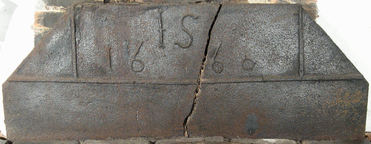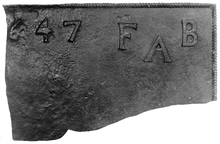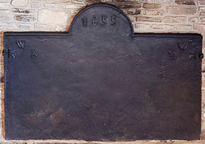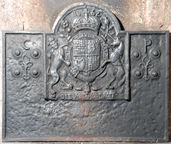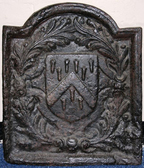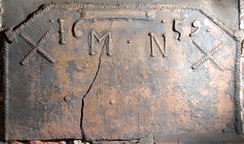-
690
Description: Canted rectangle; plain edges; broad horizontal fillet dividing the plate in two just above the side angles, with vertical fillets to top corners enclosing date and initials.
Notes: Uncharacteristically crude for the period.
Inscription: IS / 16 60
- Decoration tags:
- rectangular with canted top corners (shape)
- none (edging)
- simple stamps
- individual letters
- individual numbers
- text
Manufactured: in 1660 in the Weald area of England.
Current location: Smallhythe Place, Small Hythe Road, Tenterden, Kent, England.
Museum number: 1117951 (part of the National Trust museum group)
- Attached to series:
- Date & initials firebacks
-
1021
Description: Rectangular; cavetto-moulded edging; shield mounted on a strap-work cartouche, helm, crest, motto scroll and elaborate swirled mantling.
Notes: The arms of the Ironmongers' Company; blazon: Argent, on a chevron gules, between three gads of steel azure, three swivels or; crest: two talbots combatant encoupled together or. The true crest of the company has two salamanders (originally 'scaly lizards') rather than talbots, and it has been noted on other firebacks that salamanders are not always represented as amphibians; Samuel Lyne, in his Heraldry Display'd (1741), described the crest as 'two talbots', etc. The motto scroll is blank, indicating that the pattern was an armorial panel with a painted, rather than a carved, motto. A variant of the same fireback has the date 1660 and initials GI (Country Life, 8 March 1946, p. 450; 29 March 1946, p.588). Reeman Dansie auction, Colchester, 13 Apr 2016, lot 1224; Bellman's auction, Wisborough Green, 13 Oct 2021, lot 588 (£220).
Copies of this fireback are known.
Arms: Worshipful Company of Ironmongers
- Decoration tags:
- rectangular (shape)
- cavetto (edging)
- whole carved pattern
- armorial
Manufactured: in the mid-17th century in England.
Current location: not known.
- Attached to series:
- Livery company firebacks
- Armorial panel firebacks
-
1136
Description: Fragment; rectangular; twisted rope edging; top centre, date [1]647; top right, initials FAB in triad, A below F and B.
Notes: The initials were probably mirrored on the left side. Acquired from a location at Tintern, Monmouthshire. A fireback of near identical design and provenance was noted by David Bick at Poolway House, Coleford, Gloucestershire (Gloucs. Archives D9104).
Inscription: 647 FAB [triad]
- Decoration tags:
- rectangular (shape)
- rope (edging)
- individual letters
- individual numbers
- text
Manufactured: in 1647 probably at Tintern Furnace in the Forest of Dean area of Wales.
Current location: National Museum Wales, National Collections Centre, Heol Crochendy, Parc Nantgarw, Nantgarw, Glamorgan, Wales.
Museum number: 73.25I (part of the National Museum Wales museum group)
- Attached to series:
- Date & initials firebacks
-
860
Description: Canted rectangle; fillet edging (top and sides); top centre, initials, above date, between repeated fleur-de-lys stamp; from top corners to bottom corners, repeated V-shape pattern formed of stamped short fillets, with an L-shape inserted between the top two Vs on each side.
Notes: The fleurs de lys are of a distinctive style seen on a small group of firebacks.
Inscription: RH / 1662
- Decoration tags:
- rectangular with canted top corners (shape)
- fillet (edging)
- simple stamps
- carved stamps
- individual letters
- individual numbers
- heraldic
- text
- objects
Manufactured: in 1662 in the Forest of Dean area of England.
Current location: not known.
- Attached to series:
- Newent area group
- Fleur-de-lys firebacks
-
1091
Description: Arched rectangular shape; twisted rope edging (top and sides); date in arch; initials in triads in top corners.
Notes: A fireback at Cotehele House in Cornwall, dated 1647 and bearing the initials AA, which may have come from Longden Hall, south-west of Shrewsbury in Shropshire, and was purchased by the National Trust from Longden Parish Council in the early 1970s, is similar in both its shape and style
Inscription: 1655 / RWA [triad] / RWA [triad]
- Decoration tags:
- rectangular with round arch (shape)
- rope (edging)
- individual letters
- individual numbers
- text
Manufactured: in 1655 in England.
Current location: The Freeth, Thornbury, Herefordshire, England.
- Attached to series:
- Date & initials firebacks
-
348
Description: Composite; Arched rectangular shaped, armorial fireback, cavetto edging, with Stuart Royal arms, garter, supporters, crown and motto, and 1662 date above crown; this overlies a rectangular plate, with rope-effect, fillet edging; a pattern of four rosettes surrounding a fleur-de-lys, its stem terminating in a small buckle, is repeated on each side of the central armorial fireback, with the initials above; each rosette is stamped separately.
Notes: A variant, bearing the same date, but the initials, A B, and without the rosettes, is at Norton Manor, Malmesbury, Wiltshire. Copies were advertised in F. Parkin & Sons (Exeter) catalogue in 1967 and 1972.
Copies of this fireback are known.
Inscription: 16 62 / C P / HONI SOIT QVI MAL Y PENSE / DIEV·ET·MON DROIT
Arms: English Stuart royal
- Decoration tags:
- rectangular with round arch (shape)
- fillet (edging)
- carved stamps
- whole carved pattern
- composite
- individual letters
- armorial
- royal
- text
Manufactured: in 1662 possibly in the Forest of Dean area of England.
Current location: Tiverton Castle, Tiverton, Devon, England.
(part of the Colchester & Ipswich Museums Service museum group)
-
1157
Description: Arched rectangular shape; ovolo-moulded edging; a shield with the arms of the Grocers' Company on a cartouche, surrounded by four sprays of olive leaves.
Notes: The blazon of the arms is: Argent, a chevron gules between nine cloves six in chief and three in base proper. The arms were granted in 1532. The style of the fireback owes something to the design of French firebacks of the mid-17th century.
Copies of this fireback are known.
Arms: Worshipful Company of Grocers
- Decoration tags:
- rectangular with round arch (shape)
- ovolo (edging)
- whole carved pattern
- heraldic
- armorial
- plants
Manufactured: in the mid-17th century in England.
Current location: not known.
- Attached to series:
- Livery company firebacks
-
901
Description: Quasi-Arched rectangular shape with cyma reversa shoulders; ovolo edging; stylised lion passant guardant; crowned rose with leaf and stem on left, crowned fleur de lys on right, thistle with leaves above centre; three right-facing scrolls at base; down-facing scroll, with staple, on right side; date split between bottom corners; initials below date, bottom right.
Notes: Blatantly Royalist in its symbolism, a variant (no. 763) is dated (perhaps less convincingly) 1649. Numeral style, initials, leaf depiction and the stapled scroll are typical features of firebacks made from patterns by the same maker. A later version of the same subject, but with a different shaped plate and without the fleur-de-lys, is also known (see 'Royalist series'). M. A. Lower writes of this design of fireback being cast at Waldron Furnace in Sussex (Lower, 1849, p.219). Inferior copies of this fireback were advertised in Kings Worthy Foundry's (Winchester) catalogue in the mid-20th century.
Copies of this fireback are known.
Inscription: 16 41 / IM
- Decoration tags:
- rectangular with round arch (shape)
- ovolo (edging)
- whole carved pattern
- heraldic
- royal
- text
- animals
Manufactured: in 1641 possibly at Brede Furnace in the Weald area of England.
Current location: in private hands, Wandsworth, London, England.
- Attached to series:
- IM series
- Hooked '1' series
- Stapled scroll series
- Brede group
-
253
Description: Arched rectangular shape; cavetto moulded edging; garter enclosing Stuart royal arms, with supporters, crown and motto; date split either side of garter buckle; rectangular extension panel at bottom.
Notes: An altered casting from a 1641 original (no. 445), the last part of the date having disproportionate numerals; often copied. From the detail of the relief, probably an early casting. Inferior copies of this fireback were advertised in Kings Worthy Foundry's (Winchester) catalogue in the mid-20th century.
Copies of this fireback are known.
Inscription: C R / HONI SOIT QVI MAL Y PENSE / 16 64 / DIEV ET MON DROIT
Arms: English Stuart royal
- Decoration tags:
- rectangular with round arch (shape)
- cavetto (edging)
- whole carved pattern
- individual numbers
- extension panels
- armorial
- royal
- text
Manufactured: in 1664 possibly in the Weald area of England.
Current location: not known.
- Attached to series:
- Carolean royal armorial firebacks
- Stuart royal armorial firebacks
- Royalist series
-
725
Description: Canted rectangle with twisted rope edging; uneven, individually stamped letters and numerals, the initials separating the two parts of the date, which are raised slightly higher; dots are stamped on each side of each half of the date and between the initials; a twisted rope saltire at each end of the inscription.
Notes: The distinctive form of the number '5' has been seen on other firebacks indicating a common source. The plate above the inscription is a repair, as are the rivets either side of the crack.
Inscription: ·16· M · N ·59·
- Decoration tags:
- rectangular with canted top corners (shape)
- rope (edging)
- simple stamps
- carved stamps
- individual letters
- individual numbers
- apotropaic
- text
- objects
Manufactured: in 1659 in the Weald area of England.
Current location: in private hands, Upper Beeding, West Sussex, England.
- Attached to series:
- Rope design firebacks
- Shortened '5' series
